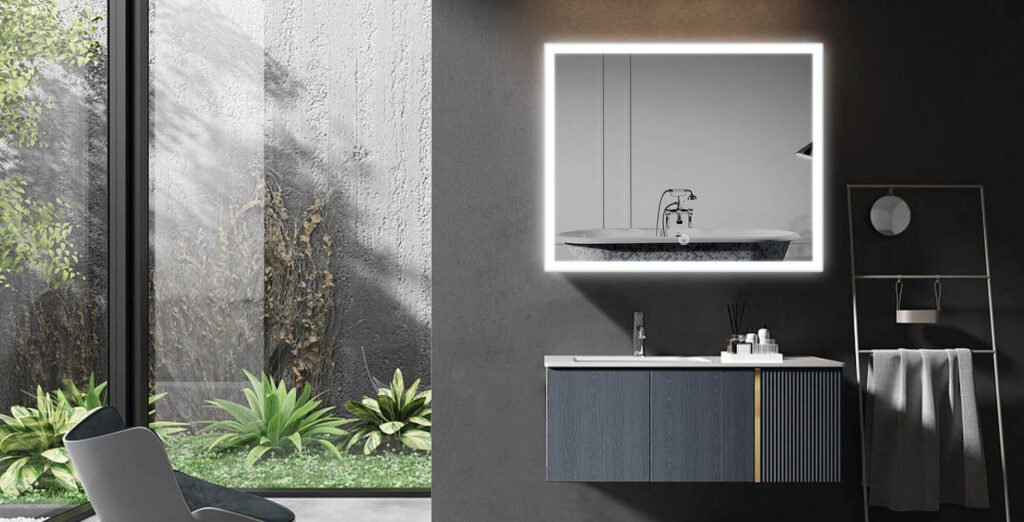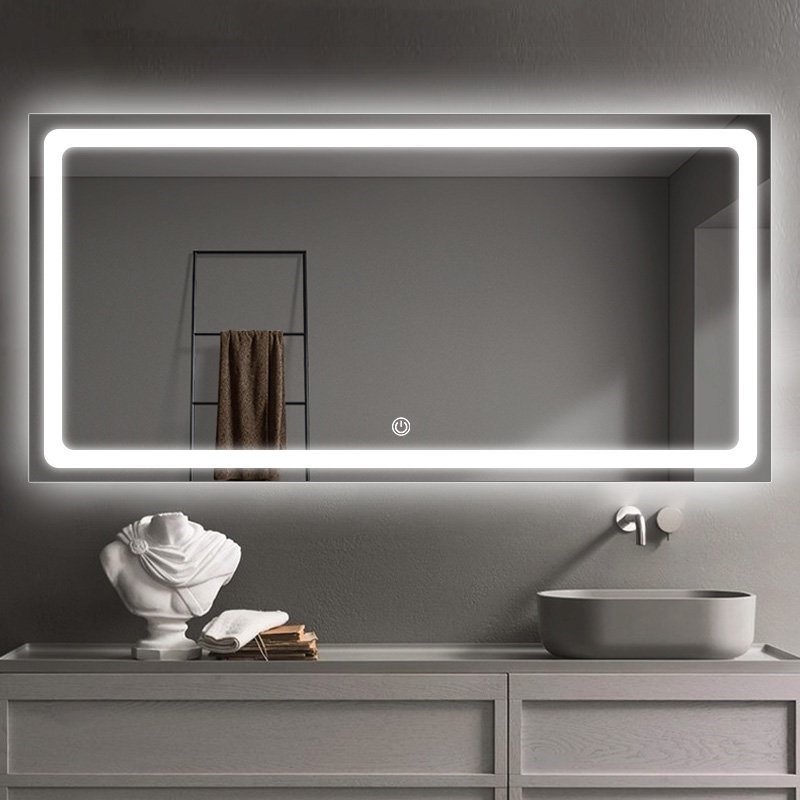|
Obtenir votre Trinity Audio joueur prêt ...
|
Desilvered Mirror is a common problem affecting many mirrors, especially in environments such as bathrooms where moisture can accelerate mirror damage. Is there a viable solution to help us with mirror desilvering?
There are several ways you can repair mirror desilvering at home yourself:
- Buy a mirror frame that not only hides the edges of the desilvering, but also adds beauty and modernity.
- You can use silver foil to repair it. Cut the silver foil to the same size as the desilvered area, coat it with glass glue and stick it to the desilvered area of the mirror.
- Spray silver paint on the desilvered area. Spray the silver paint evenly around the desilvered area, usually more than two coats.
- Use silver wire. Cut the thin silver wire into the same length as the mirror’s desilvering area, apply glass adhesive and stick it on the desilvering area, and press it firmly.
Let’s delve into the common causes of desilvering, how to repair it, and practical steps to prevent it from happening again.

What is Desilvering on a Mirror?
Desilvering is when the reflective coating on the back of a mirror peels or deteriorates. It’s usually caused by exposure to moisture, improper cleaning, or a defect in the mirror manufacturing process. The result is ugly black spots, cloudy areas, or a complete loss of reflection in certain spots. We typically associate desilvering with bathroom mirrors because of the high humidity. Cependant, desilvering can occur anywhere moisture is present.
Mirror desilvering is when the reflective coating breaks down, usually because of moisture, harsh chemicals, or poor manufacturing. This results in black spots or cloudy areas on the mirror.
The reflective coating on a mirror is usually silver or aluminum. When this coating is exposed to moisture or harsh cleaning agents, it begins to degrade. This condition is known as “mirror rot” or desilvering.
The first signs of desilvering usually show up as small black spots around the edges or in patches. Au fil du temps, the damage can spread, ruining the mirror. According to a study by the American Society for Testing and Materials (ASTM), mirrors in high-humidity environments can lose up to 30% of their reflective quality within 3 years of exposure to moisture.
Why Do Mirrors Turn Black?
Mirrors turn black when the reflective coating on the back of the mirror starts to break down, causing the silvering to peel off and turn black. Exposure to moisture, chemicals, or shoddy manufacturing can make the problem worse. Mirrors are particularly susceptible to blackening in bathrooms or kitchens, where the environment is always humid.
Black spots in a mirror are usually caused by the reflective coating breaking down, often due to moisture, poor maintenance, or poor-quality manufacturing.
The breakdown of the silvering layer is the most common cause of black spots in mirrors. In bathrooms, where humidity levels are high, moisture can seep into the edges of the mirror, causing oxidation of the reflective layer. Once the reflective coating starts to peel off, the mirror no longer reflects light properly, causing dark patches.
Cleaning products that contain ammonia or abrasive materials can also speed up the breakdown. According to research by the National Association of Home Builders (NAHB), mirrors in a bathroom environment are 60% more likely to desilver within the first 5 years of installation than mirrors in dry areas.
How to Fix Mirror Desilvering?
There are a few ways to fix desilvering, depending on how bad it is. For minor problems, like small black spots or edges, you can use a mirror desilvering kit or mirror edge repair tape. For more serious problems, you may need to have the mirror resilvered to restore its reflectivity.
You can fix mirror desilvering with a desilvering mirror kit, mirror edge repair tape, or by resilvering the entire mirror, depending on the damage.
If you want to fix a desilvered mirror, the first thing you need to do is clean the area. Get all the dirt, grime, and moisture off. If it’s a small area, you can use a mirror desilvering kit. These kits typically include a reflective silvering solution or spray. This solution helps to restore the damaged area by reapplying a thin layer of reflective material.
For more extensive desilvering, you may need to have the mirror resilvered. Resilvering involves applying a new layer of silver or aluminum to the back of the mirror, making it work like new. Dans un 2021 Consumer Reports survey, homeowners who had mirrors resilvered reported a 95% satisfaction rate. The process greatly improved the appearance and life of the mirror.

How to Repair Mirror Desilvering?
Repairing mirror desilvering depends on how bad it is. If it’s just a little discolored or has a few small black spots, you can buy a mirror desilvering kit or use silvering paint to repair it. But if it’s really bad, you may have to have the mirror completely resilvered.
You can use a desilvering mirror kit to repair minor desilvering or resilver the entire mirror if the desilvering is more extensive.
When repairing mirror desilvering, the first step is to determine how bad it is. If it’s just a few small black spots or edges, you can use a mirror desilvering kit or silvering spray and apply it directly to the affected area. These kits usually contain a reflective solution that can restore small areas of silvering.
For larger, more severe damage, resilvering is the best option. This process involves cleaning the mirror thoroughly, stripping off the old reflective material, and then applying a new layer of silver or aluminum to the back of the glass. Selon le Glass Association of North America (GANA), resilvering a mirror can extend the life of the mirror by 10-15 années, depending on how the mirror is used and maintained.
How to Fix Black Edges on Mirrors?
Black edges on mirrors are typically caused by the reflective coating deteriorating because of exposure to moisture or poor sealing. You can fix these black edges by using a mirror edge repair tape or silvering spray for minor repairs, or you can resilver the entire mirror.
Fix black edges on mirrors by using a mirror edge repair tape or applying a silvering solution to restore the reflective coating.
For minor damage along the edges, mirror edge repair tape is a simple and effective solution. This tape covers the damaged areas, protecting the mirror from further degradation and restoring its appearance. In cases of more widespread damage, resilvering may be the best solution.
This process will replace the lost silvering, ensuring that the entire mirror remains functional and visually appealing. According to a report from Home Improvement Magazine, homeowners who used edge repair tape found that it effectively restored their mirror’s look for up to 2 years before needing additional repairs.
What Causes Mirror Desilvering?
Mirror desilvering occurs when the silvering (reflective coating) begins to degrade. The main causes include prolonged exposure to moisture, improper cleaning, and poor manufacturing quality. Mirrors in bathrooms are particularly vulnerable to desilvering due to high humidity levels.
Desilvering is caused by moisture, poor cleaning practices, or faulty manufacturing that leads to the breakdown of the reflective coating.
The most common cause of mirror desilvering is moisture exposure. When mirrors are placed in humid environments, such as bathrooms or kitchens, the reflective coating can oxidize, leading to black spots and cloudiness. En plus, using harsh cleaning chemicals can accelerate this process. Mirrors that are not sealed properly are more likely to suffer from desilvering over time. Selon le Journal of Environmental Health (2019), bathroom mirrors exposed to high humidity levels can experience up to a 40% reduction in reflective quality within 5 années.

How to Prevent Mirror Desilvering?
To prevent desilvering, it’s important to protect your mirrors from moisture and ensure they are cleaned properly. Consider using a protective sealant around the edges, installing ventilation fans in bathrooms, and using gentle cleaning agents that won’t damage the reflective coating.
Prevent mirror desilvering by keeping mirrors dry, sealing the edges, and using non-abrasive cleaning methods.
The best way to prevent mirror desilvering is to ensure that mirrors are not exposed to excessive moisture. Installing exhaust fans in bathrooms to reduce humidity levels is one of the most effective strategies. After showering, wiping down the mirror to remove moisture is also recommended. En plus, using non-abrasive cleaners and microfiber cloths will help maintain the integrity of the reflective coating. According to a study from the National Association of Home Builders (NAHB), homes with well-ventilated bathrooms see a 50% decrease in mirror desilvering rates compared to those without proper ventilation.
Mirror Resilvering: Is It Worth It?
Resilvering a mirror can be a good investment if the reflective coating has been severely damaged. This process restores the mirror’s reflective quality and can extend its lifespan, but it can be expensive and time-consuming.
Mirror resilvering restores the reflective layer, but it can be costly. It’s an effective solution for severely desilvered mirrors.
Resilvering involves reapplying a reflective silver or aluminum coating to the back of the mirror. It’s a professional service that requires specialized equipment and expertise. While it may be expensive, it can significantly enhance the mirror’s lifespan, restoring its functionality and aesthetic appeal. For mirrors with large areas of desilvering, resilvering is the most effective solution. Home Renovation Pros reported that mirrors resilvered by professionals last 5-10 years longer than mirrors left unrepaired.

Conclusion
Fixing a desilvered mirror is possible, whether you opt for DIY repairs like using a mirror desilvering kit or hire a professional for resilvering. Taking steps to prevent moisture exposure and using the right cleaning methods can help maintain the mirror’s integrity for years to come. Whether you’re dealing with a miroir de salle de bain ou un miroir LED sur mesure, addressing desilvering early will save you time and money in the long run.
























